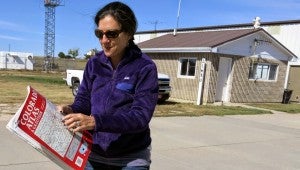
EDF’s Jennifer Pitt prepares for her flight. EDF partnered with LightHawk to increase understanding of the impacts of water imports to population centers in Colorado’s Front Range. Photo credit: David Owen with support from LightHawk.
I’ve been a student of water use, storage and transportation for decades, but never before have I seen the collection and diversion systems from the air, other than a glimpse of a big reservoir from a commercial jet. That is, not until a few weeks ago, when I had the extraordinary opportunity to fly with a LightHawk volunteer pilot to see Colorado’s waterworks from the air.
Seeing the landscape from above gave me a completely new perspective.
The point of my trip was to see the effects that Colorado’s urban growth – with its increasing urban water demands – is having on the state’s working lands and rivers. One view painted a very clear picture: a footprint of idled farmland in Rocky Ford, Colorado.









